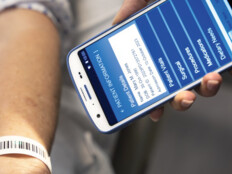Effective Infrastructure Investments Make Healthcare Mobility Programs a Success
One of the primary benefits of healthcare mobility is simplicity. Clinicians can use a single device for a variety of tasks. But before deploying such tools or instituting a BYOD policy enabling personal device use, an organization first must ensure it has the infrastructure in place to support its planned mobility initiatives.
Equally critical is that healthcare mobility programs must include a strong management plan. HIPAA requires organizations to ensure the privacy and protection of their data. Guaranteeing network performance and continuity is essential in healthcare, as a lost connection could mean the difference between life and death.
Establishing a solid infrastructure can be challenging for healthcare organizations because wireless networks in hospitals, clinics and physicians’ offices often must provide support for more than just smartphones and tablets. Such setups might need to be robust enough to incorporate building automation functionality, including lighting, thermostat and access control systems, and medical equipment, such as telemedicine and patient monitoring systems.
The list of uses for wireless networks continues to grow, as provider organizations begin to delve into innovative tools such as augmented and virtual reality for patient care. To that end, organizations must consider scalability when planning their wireless infrastructure.
Facility Assessments Head Off Infrastructure Issues
Prior to considering network equipment, an organization must assess its physical infrastructure. Older buildings, especially hospitals, pose greater challenges when it comes to supporting a wireless network because of dense construction materials, such as brick and concrete, that block signals.
When organizations build new facilities, they should plan for long-term network initiatives during the construction phase by considering the materials used and the placement of elevators and bathrooms that are more conducive to wireless networks.
That is often easier said than done. Even putting a wireless access point in every room would meet today’s needs only marginally — it would not be sufficient, for instance, for a hospital considering the use of virtual reality headsets for pain control.
Organizations also must thoroughly examine the number of channels available and ensure that they don’t interfere with one another. IT staff must also make sure to locate APs and user devices away from medical devices that may emit potentially strong interference or be impaired by wireless traffic.
The best way to ensure a robust infrastructure for an older building or new construction is to conduct a wireless network assessment. Third parties regularly work with clients to evaluate their legacy infrastructure and determine what they need to reach their current and future network goals.
Each wireless deployment is different, but solution architects and engineers can engage clients in discussions about their needs and network best practices to help lay the groundwork for any wireless plans. They can walk an organization through by asking these questions:
- Is the network optimized for voice?
- Is the facility VoIP-ready? For instance, does it have a digital private branch exchange that supports Session Initiation Protocol trunking or Primary Rate Interface?
- What type of devices will access the network? Are they compatible? What types of accessories will they need?
- What will the device lifecycle look like?
- Will the organization need a 24⁄7 help desk?
- Which systems, such as admissions, discharges and transfers, will be integrated with wireless devices?
This is just a small sample of the issues to consider during a wireless network assessment. Third-party solution architects and engineers can also help organizations determine key performance indicators so they can measure the success of their initiatives and help to plan out pilot projects, as well as the overall rollout.
EMM Prompts Security, Continuity and More
Once the infrastructure is in place for a mobile rollout, an enterprise mobility management solution can help organizations keep data secure, monitor performance and responsiveness, and ensure network continuity.
Through EMM, IT staff can manage both corporate-owned and personal devices that connect to the network. But EMM doesn’t focus on the devices alone; it combines mobile device, application and content management all in one.
With an EMM console, administrators can monitor and secure devices, encrypt them and lock or wipe them remotely in the event of loss or theft. Healthcare organizations with BYOD policies can also use EMM to manage the applications and content on individual devices. They can also manage the licensing, delivery and preconfiguration of applications, and set access control and data-sharing policies to protect sensitive content.
That’s critical due to the regulatory requirements of healthcare and the ever-growing presence of cyberthreats. Healthcare security professionals surveyed by the Healthcare Information and Management Systems Society (HIMSS) cite medical device security as a major focus and say patient safety, data breaches and malware are their top concerns. Administrators can set up alerts and real-time updates of network and device activity to help them manage performance and connectivity. An EMM solution can also run analytics for reporting and auditing.
With help from third-party solution architects and engineers, healthcare organizations can conduct wireless assessments, craft mobile strategies based on the results, and select and implement EMM solutions that will help them manage mobility today and into the future.
Healthcare providers now more than ever deploy mobile technology to enable timely patient care and boost collaboration. Learn more by downloading the white paper "Mobile Technology Enhances Next-Generation Care Delivery."








